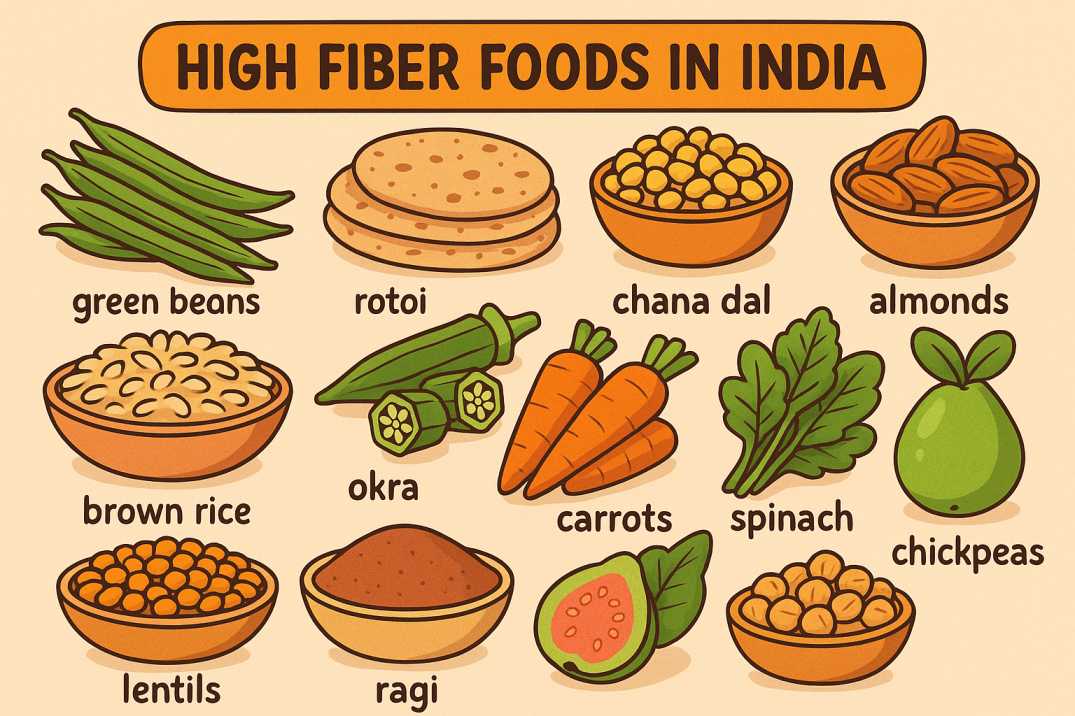High Fiber Foods in India: Boost Your Health with Fiber-Rich Foods

In today’s fast-paced world, dietary choices play a crucial role in determining overall health. One often overlooked but vital nutrient is dietary fiber. A high-fiber diet has been shown to support digestion, prevent constipation, and reduce the risk of chronic diseases. This article explores the top 20 sources of fiber available in India, helping you make informed decisions to improve your well-being.
Introduction to High-Fiber Foods and Their Importance
In today’s fast-paced world, dietary choices play a crucial role in determining overall health. One often overlooked but vital nutrient is dietary fiber. A high-fiber diet has been shown to support digestion, prevent constipation, and reduce the risk of chronic diseases. This article explores the top 20 sources of fiber available in India, helping you make informed decisions to improve your well-being.
What is Dietary Fiber? Types and Functions
Dietary fiber refers to the plant-based carbohydrates that are not digested by the body. It is mainly classified into:
Soluble fiber: Dissolves in water, helps lower blood glucose and cholesterol levels.
Insoluble fiber: Does not dissolve in water and aids in moving material through the digestive system.
Sources like fruits, vegetables, legumes, and grains provide both types. Including a mix of both types in your meals ensures comprehensive health benefits.
Which Indian Food Is Rich in Fiber?
India offers a wide variety of fiber-rich foods due to its plant-based culinary diversity. Fiber is an essential nutrient that aids digestion, manages blood sugar levels, lowers cholesterol, and helps in weight management. Several traditional Indian foods are packed with both soluble and insoluble fiber, making them excellent additions to a healthy diet.
Top Indian Fiber-Rich Foods
1. Whole Grains
Ragi (Finger Millet): Known for its high fiber content, Ragi is a staple in South India. It also helps control blood sugar and supports heart health.
Brown Rice: Unpolished brown rice retains its bran and germ layers, which are loaded with fiber and nutrients.
Whole Wheat (Atta): Used in making chapatis and parathas, whole wheat is a daily fiber contributor in Indian households.
2. Pulses and Legumes
Chana Dal (Bengal Gram Split): Rich in both fiber and protein.
Lentils (Masoor, Moong, Toor): Boiled or sprouted lentils are a fiber powerhouse.
Chickpeas (Chole): Extremely high in dietary fiber and commonly used in curries and salads.
3. Fruits and Vegetables
Guava: One of the best Indian fruits rich in fiber and Vitamin C.
Carrots, Spinach, Okra (Bhindi), and Beans: These vegetables are widely used in Indian sabzis and provide ample fiber.
Sweet Potatoes: Consumed roasted or in curries, they offer a fiber-rich alternative to regular potatoes.
4. Nuts and Seeds
Almonds and Flaxseeds: These are not only rich in fiber but also contain healthy fats and micronutrients.
Daily Use Tip:
Combining roti made from whole wheat flour with a sabzi of okra or spinach, and a bowl of dal creates a fiber-rich Indian meal. Include seasonal fruits like guava or banana for added fiber.
What Does Fiber Do for a Body?
Dietary fiber is a type of carbohydrate found in plant-based foods that the body cannot digest or absorb. Instead of being broken down and absorbed, fiber passes relatively intact through your stomach, small intestine, and colon. Despite this, fiber plays a crucial role in maintaining overall health.
Types of Fiber
Soluble Fiber: Dissolves in water and forms a gel-like substance. It helps lower blood cholesterol and glucose levels.
Insoluble Fiber: Promotes the movement of material through the digestive system and increases stool bulk.
Key Health Benefits of Fiber:
1. Improves Digestive Health
Fiber helps in adding bulk to stool and prevents constipation. It also supports healthy gut bacteria, which improves digestion and immunity.
2. Controls Blood Sugar Levels
Soluble fiber, in particular, slows the absorption of sugar and improves blood sugar levels. It is beneficial for people with diabetes or those at risk.
3. Supports Heart Health
By lowering LDL (bad cholesterol) levels, fiber helps reduce the risk of cardiovascular diseases. It also lowers blood pressure and inflammation.
4. Aids in Weight Management
Fiber-rich foods are more filling, helping to reduce overall calorie intake. They also help regulate appetite by slowing digestion.
5. Prevents Certain Diseases
Higher intake of dietary fiber is linked with a lower risk of developing diseases like colorectal cancer, type 2 diabetes, and obesity.
Daily Recommendation
Men: 30–38 grams/day
Women: 21–25 grams/day
What Foods Are Highest in Fibre?
If you’re aiming to increase your fiber intake, certain foods rank higher than others. Below is a list of the highest fiber foods globally, many of which are readily available or have Indian counterparts.
Top High-Fiber Foods
1. Legumes and Pulses
Split Peas: One cup offers over 16 grams of fiber.
Lentils: About 15 grams per cooked cup.
Black Beans, Kidney Beans, and Chickpeas: Packed with fiber and protein.
2. Whole Grains
Bran (Wheat or Oat): The outer layer of grains, very high in fiber.
Quinoa, Barley, and Bulgur: Nutritious alternatives to rice and wheat.
Oats: Rich in beta-glucan fiber, which lowers cholesterol.
3. Fruits
Raspberries, Pears (with skin), Apples (with skin): Excellent fiber sources.
Bananas and Oranges: Provide both fiber and essential vitamins.
4. Vegetables
Artichokes, Broccoli, Brussels Sprouts, and Carrots: High in fiber and nutrients.
Sweet Potatoes and Beets: Root vegetables that pack a fiber punch.
5. Nuts and Seeds
Chia Seeds: One tablespoon offers around 5.5 grams of fiber.
Flaxseeds and Almonds: Fiber-rich with added healthy fats.
Indian Adaptation of High-Fiber Foods:
Replace white rice with brown rice or quinoa.
Include dal or legumes in at least one meal a day.
Snack on nuts or roasted chickpeas instead of processed foods.
Add fruits like guava or papaya to your breakfast.
Health Benefits of a High-Fiber Diet
Consuming a high-fiber diet offers numerous advantages:
Improved Digestion: Fiber regulates bowel movements.
Weight Management: Keeps you full for longer.
Heart Health: Helps lower LDL cholesterol.
Blood Sugar Control: Slows sugar absorption.
Gut Health: Promotes beneficial gut bacteria.
Studies from Harvard Health affirm these health benefits.
Which Indian Food is Rich in Fiber?
India offers a wide array of naturally high-fiber foods, many of which are already a part of traditional meals. Common Indian staples like dal (lentils), whole wheat chapati, oats, and vegetables are great sources of dietary fiber. Regional cuisines feature foods like:
Bajra (Pearl Millet) – High in insoluble fiber, it supports digestion and is commonly used in rural diets.
Ragi (Finger Millet) – Rich in both fiber and calcium, ideal for breakfast meals like ragi porridge.
Bhindi (Lady Finger) and Lauki (Bottle Gourd) – Excellent fiber-rich veggies that help improve bowel movement.
Raw Fruits – Guava, apple (with skin), and papaya are readily available and rich in soluble and insoluble fiber.
Integrating these foods into daily meals ensures fiber adequacy and improves overall health.
What Does Fiber Do for a Body?
Fiber plays a crucial physiological role in maintaining health. It benefits multiple systems of the body:
Digestive Health: Insoluble fiber adds bulk to stool and promotes regular bowel movement, preventing constipation and bloating.
Heart Health: Soluble fiber helps reduce LDL (bad cholesterol) and triglyceride levels, reducing the risk of heart disease.
Blood Sugar Regulation: Fiber slows down glucose absorption, preventing sugar spikes in diabetics.
Weight Management: High-fiber foods make you feel fuller longer, reducing the urge to snack frequently.
Gut Microbiota Support: Certain types of fiber act as prebiotics, feeding beneficial gut bacteria and improving immunity.
Doctors recommend an average daily intake of 25-30 grams of fiber for adults, which can be achieved through a balanced, plant-based diet.
What Foods Are Highest in Fibre?
Some foods are naturally very high in fiber content and should be part of a balanced diet. The highest fiber foods include:
Chia Seeds – 34g of fiber per 100g
Flaxseeds – Rich in fiber and omega-3 fatty acids
Split Peas and Lentils – Around 15-16g per cooked cup
Oats – A powerhouse of beta-glucan soluble fiber
Almonds – Offer 12-13g fiber per 100g
Broccoli – Packed with both fiber and antioxidants
Apples (with peel) – A good source of soluble fiber (pectin)
Consistently eating a mix of legumes, whole grains, vegetables, and fruits ensures optimal fiber intake.
A Complete List of High Fibre Rich Foods in India
Here is a detailed list of the best high-fiber foods in India, categorized by food groups:
Fruits:
Guava
Apple (with peel)
Banana
Papaya
Orange
Pear
Vegetables:
Spinach
Carrots
Green peas
Cabbage
Broccoli
Okra (Bhindi)
Legumes & Pulses:
Masoor dal (Red Lentils)
Chana dal (Bengal Gram)
Rajma (Kidney Beans)
Moong dal (Green Gram)
Kabuli Chana (Chickpeas)
Whole Grains:
Oats
Brown rice
Bajra
Ragi
Barley (Jau)
Whole wheat atta
Nuts & Seeds:
Almonds
Flaxseeds
Pumpkin seeds
Sunflower seeds
Chia seeds
This diverse list allows for the inclusion of fiber in every meal. Rotating between these categories ensures a variety of nutrients along with fiber.
High-Fiber Vegetables in India
Vegetables are a natural source of fiber. Indian fiber-rich vegetables include:
Spinach (Palak) – Rich in insoluble fiber and iron.
Green Peas – High in both soluble and insoluble fiber.
Carrots – Loaded with beta-carotene and fiber.
Cabbage – Great for digestion and low in calories.
Include these in your curries, stir-fries, or salads for a fiber boost.
High-Fiber Fruits for Daily Consumption
Fruits not only add flavor but also contribute significantly to your fiber intake. Recommended high-fiber fruits include:
Guava – One of the richest sources of fiber.
Banana – Offers soluble fiber and supports digestion.
Apple (with skin) – Contains pectin, a soluble fiber.
Pears – High in fiber and antioxidants.
Aim to eat whole fruits instead of juices to retain their fiber content.
Legumes and Pulses: Fiber Powerhouses
Legumes are staple foods in Indian diets and serve as excellent fiber sources:
Masoor Dal – Rich in both protein and fiber.
Chickpeas – Good for heart health and weight management.
Black Beans – Promote gut health.
Combine them with brown rice or whole wheat for a complete meal.
Whole Grains and Cereals Rich in Fiber
Whole grains are significantly better than refined ones due to their fiber content:
Oats – Excellent for heart health.
Brown Rice – Retains its bran layer for more fiber.
Whole Wheat – Found in atta and bread.
Barley (Jau) – Improves blood sugar regulation.
Use these in your breakfast and lunch for optimal benefit.
Nuts and Seeds that Add Fiber to Your Diet
Don’t underestimate the fiber in small packages:
Almonds – Packed with fiber and healthy fats.
Pumpkin Seeds – Great as snacks or toppings.
Flaxseeds – Contain omega-3 and high fiber.
Include a handful daily for digestive and heart health.
Tips to Incorporate More Fiber into Your Meals
To successfully follow a high-fiber diet:
Replace white rice with brown rice.
Snack on fruits instead of chips.
Add seeds to smoothies or salads.
Use whole wheat flour in baking.
Hydrate well, as fiber needs water to move through the digestive system efficiently.
Common Myths About High-Fiber Foods
Let’s bust some myths:
Myth: Only old people need fiber. Fact: Fiber is essential at all ages.
Myth: Fiber is only for digestion. Fact: It aids heart health, weight loss, and blood sugar control.
Myth: Fiber-rich foods are bland. Fact: Many are delicious and versatile.
Being informed helps you make healthier choices.
What is Dietary Fiber? Types and Functions
Dietary fiber refers to the plant-based carbohydrates that are not digested by the body. It is mainly classified into:
Soluble fiber: Dissolves in water, helps lower blood glucose and cholesterol levels.
Insoluble fiber: Does not dissolve in water and aids in moving material through the digestive system.
Sources like fruits, vegetables, legumes, and grains provide both types. Including a mix of both types in your meals ensures comprehensive health benefits.
Health Benefits of a High-Fiber Diet
Consuming a high-fiber diet offers numerous advantages:
Improved Digestion: Fiber regulates bowel movements.
Weight Management: Keeps you full for longer.
Heart Health: Helps lower LDL cholesterol.
Blood Sugar Control: Slows sugar absorption.
Gut Health: Promotes beneficial gut bacteria.
Studies from Harvard Health affirm these health benefits.
Top 20 High-Fiber Foods Available in India
Here’s a comprehensive list of 20 high-fiber foods commonly found in Indian kitchens:
Lentils (Masoor Dal)
Black Beans (Kali Rajma)
Chickpeas (Chana)
Oats
Brown Rice
Whole Wheat Roti
Spinach (Palak)
Carrots
Apples
Guava
Bananas
Oranges
Pumpkin Seeds
Almonds
Flaxseeds
Pears
Barley (Jau)
Sweet Potatoes
Green Peas
Cabbage
Each item provides a unique nutrient profile, making it easier to meet your daily fiber needs.
High-Fiber Vegetables in India
Vegetables are a natural source of fiber. Indian fiber-rich vegetables include:
Spinach (Palak) – Rich in insoluble fiber and iron.
Green Peas – High in both soluble and insoluble fiber.
Carrots – Loaded with beta-carotene and fiber.
Cabbage – Great for digestion and low in calories.
Include these in your curries, stir-fries, or salads for a fiber boost.
High-Fiber Fruits for Daily Consumption
Fruits not only add flavor but also contribute significantly to your fiber intake. Recommended high-fiber fruits include:
Guava – One of the richest sources of fiber.
Banana – Offers soluble fiber and supports digestion.
Apple (with skin) – Contains pectin, a soluble fiber.
Pears – High in fiber and antioxidants.
Aim to eat whole fruits instead of juices to retain their fiber content.
Legumes and Pulses: Fiber Powerhouses
Legumes are staple foods in Indian diets and serve as excellent fiber sources:
Masoor Dal – Rich in both protein and fiber.
Chickpeas – Good for heart health and weight management.
Black Beans – Promote gut health.
Combine them with brown rice or whole wheat for a complete meal.
Whole Grains and Cereals Rich in Fiber
Whole grains are significantly better than refined ones due to their fiber content:
Oats – Excellent for heart health.
Brown Rice – Retains its bran layer for more fiber.
Whole Wheat – Found in atta and bread.
Barley (Jau) – Improves blood sugar regulation.
Use these in your breakfast and lunch for optimal benefit.
Nuts and Seeds that Add Fiber to Your Diet
Don’t underestimate the fiber in small packages:
Almonds – Packed with fiber and healthy fats.
Pumpkin Seeds – Great as snacks or toppings.
Flaxseeds – Contain omega-3 and high fiber.
Include a handful daily for digestive and heart health.
Tips to Incorporate More Fiber into Your Meals
To successfully follow a high-fiber diet:
Replace white rice with brown rice.
Snack on fruits instead of chips.
Add seeds to smoothies or salads.
Use whole wheat flour in baking.
Hydrate well, as fiber needs water to move through the digestive system efficiently.
Common Myths About High-Fiber Foods
Let’s bust some myths:
Myth: Only old people need fiber. Fact: Fiber is essential at all ages.
Myth: Fiber is only for digestion. Fact: It aids heart health, weight loss, and blood sugar control.
Myth: Fiber-rich foods are bland. Fact: Many are delicious and versatile.
Being informed helps you make healthier choices.
Why Fiber is Essential for a Healthy Diet
In conclusion, incorporating high-fiber foods is a simple yet effective way to improve your health. From improved digestion to better heart and metabolic health, the benefits are undeniable. Ensure you’re consuming fiber from diverse sources: fruits, vegetables, grains, and legumes.
For optimal results, pair your high-fiber diet with adequate water intake and regular physical activity.
Start your journey to better health today by gradually increasing your fiber intake. Bookmark this list of 20 high-fiber foods and share it with friends and family. For more health articles, visit TheViralLines.net.
Powered by Froala Editor
You May Also Like

Premium Link Building Agency in West Virginia | Rank 1st In Search Results

Pelvic Organ Prolapse | Plano, Frisco, Dallas TX | Female Pelvic Surgery

Link Building Services Agency in Wyoming | Expert SEO & Digital Growth

अनंतम हाईवेज़ ट्रस्ट का आईपीओ 7 अक्टूबर से खुलेगा

उर्वशी रौतेला ने पेरिस फैशन वीक में मचाया धमाल, ग्लोबल फैशन पावरहाउस आइकन के रूप में अपनी पहचान की पुष्टि की

